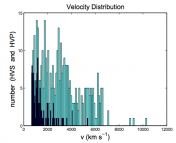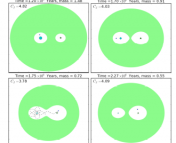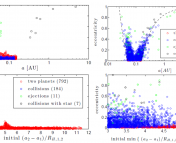Title: The Ice Coverage of Earth-like Planets Orbiting FGK Stars
Authors: Caitlyn Wilhelm, Rory Barnes, Russell Deitrick, and Rachel Mellman
First Author’s Institution: Department of Astronomy, University of Washington, Seattle, WA, USA
Status: accepted to the Planetary Science Journal

Credits: ESO
Snowballs or Entirely Ice-Free?
Determining an exoplanet being in the habitable zone is just the first step in actually predicting its surface conditions. Planets located at the exact same distance from the exact same type of host star may still have vastly different surfaces. Many more factors, aside from the semimajor axis and host star type, such as eccentricity and obliquity (tilt of the rotational axis) as well as atmospheric composition, influence the climate and environment on a planet’s surface.
One major player in this general topic is ice coverage. Earth has icy polar caps now, but this is by far not the only scenario for ice coverage for a habitable planet. It is not even necessary to look at different planets, to find evidence of this. In the past, Earth itself has changed the amount and location of surface ice several times, evolving from completely ice covered (“Snowball”) to entirely ice-free and now frozen polar caps.
The authors of today’s paper have taken a look at the different forms of ice coverage that we may encounter when examining exoplanets orbiting F, G and K stars.
Especially the case of equatorial ice belts has not been considered in depth by past studies. Previous works have shown that these sort of ice belts may form on planets with obliquities above 54°, since in these cases, the instellation (the incident radiant energy emitted by the host star, which reaches the planet in a certain region) is lower in the equatorial regions than for the poles.
It is possible to identify the location of ice-covered zones on exoplanets by measuring the albedo, considering that the ice on Earth’s polar caps contributes to around half the albedo in these areas.
Simulating Ice Coverage
When trying to predict the frequency or nature of some physical occurrence, usually scientists revert to models. In this case, a 1-D energy balance model (EBM) was used to simulate the climate of a variety of habitable planets across many different parameter combinations. The particular model utilized for this work was calibrated to Earth-like planets, i.e. planets with a similar rotational period, mass, geography and atmospheric composition as modern Earth. Further, a 75%/25% split between sea and land, respectively, was assumed. Two distinct groups of simulations were conducted: “static” and “dynammic” cases. For the “static” cases, the orbital and rotational parameters of the planetary system were assumed to be stable. The authors examined the results for both ice-free (warm start, average global temperatures at 15°C) and ice-covered (cold start, average global temperatures at -40°C) initial conditions for these static cases.
“Dynamic” cases included idealized variations of eccentricity and obliquity over the simulated time span. Further, the authors decided to always assume an ice-free initial state for the dynamic cases, i.e. a warm start. Dynamic cases were simulated for 1 million years while static cases were simulated for a time span of 1000 years, giving the climate enough to stabilize for both cases.
For the dynamic cases, for each host star type, five different cases (A, B, C, D and E) were explored, each with a different set of variations, ranging from the eccentricity, obliquity, semimajor axis to the rotational period.
In order to make qualitative statements about the results, climate states were summarized in five categories: moist greenhouse, ice free, ice caps, ice belt or total glaciations (“snowball”).
The authors made realistic assumptions about the distribution of eccentricity and obliquity for Earth-like planets according to the measured values for exoplanets fitting into this category, excluding orbitally locked planets since their parameter evolution is influenced by a very different environment and set of starting conditions.
Results for Static Planets
Figures 1, 2 and 3 show the parameter combinations for the different ice coverage scenarios for planets on circular orbits around K, G and F dwarfs, respectively, assuming a static case with no orbital or rotational variants for both warm and cold starts.

Source: Figure 3 from today’s paper
The authors found that for warm starts, ice caps may form on planets around Sun-like hosts with axial tilts smaller than 40° and an incident stellar radiation between 0.94 and 1.2 times the one received on Earth, while ice belts need axial tilts greater than 47° and an incident stellar radiation between 0.9 and 1.0 times the solar radiation received on Earth. Thus, we can clearly see that Earth fits nicely into the polar ice cap category, but if it had a larger obliquity, Earth could form equatorial ice belts.
For cold starts, the results show, as expected, that an ice free state needs a higher instellation but also that polar caps are apparently impossible, while ice belts are much more stable.
The authors also find that ice belts only form on land. This may be explained by the lower albedo of water causing higher temperatures and the higher heat capacity, which dampens the seasonal cycles and causes warmer winters in water dominated areas. Finally, the sea does not support ice as thick as it may form on land.
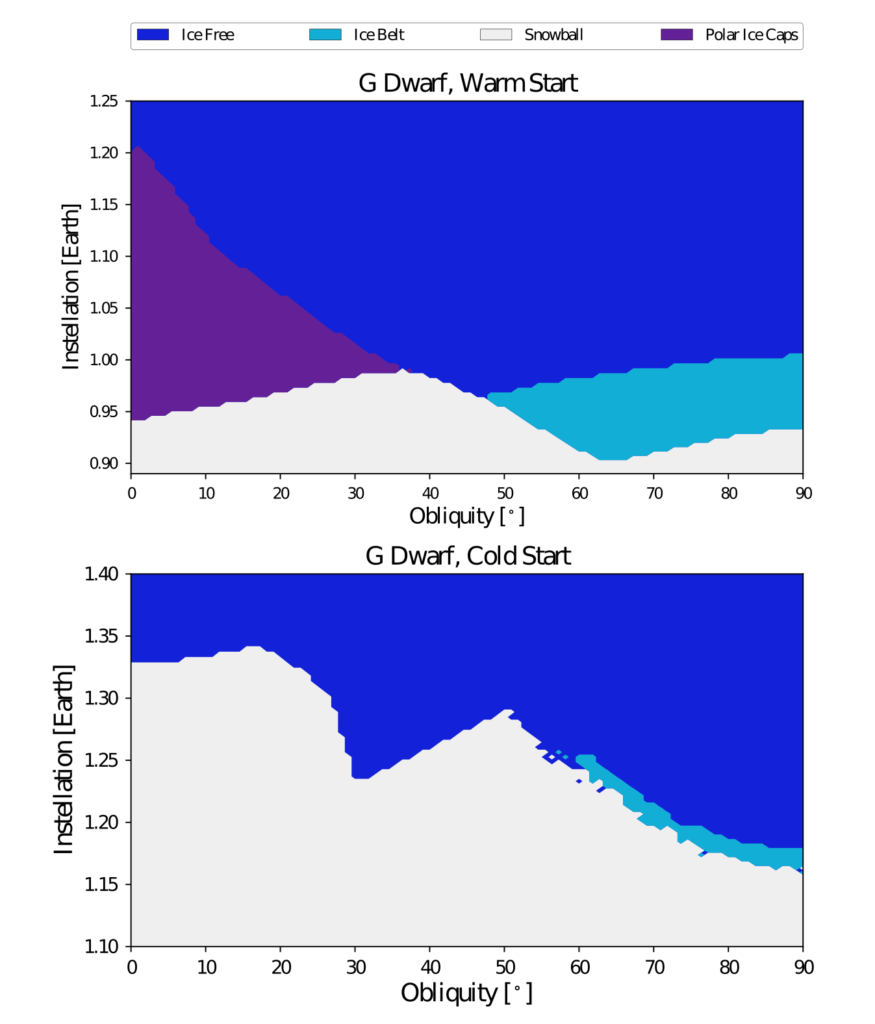
Source: Figure 4 from today’s paper
We can also see that the closer the obliquity comes to 0°, polar caps form more easily, since the poles are in eternal darkness for a perfectly vertical axis. As the axial tilt increases, the planet becomes ice-free more easily, but since the region where polar caps can actually form narrows, the snowball state may be achieved at increasing instellation as well. Around an obliquity of ~ 40°, only ice-free or snowball states exist. Increasing the obliquity further results in the possibility of ice belt formation, since the equatorial temperatures decrease, allowing for ice formation in these regions at higher instellations.
For F and K host stars, the results are somewhat similar but there are some differences in the boundaries between ice states. While polar cap regions remain relatively similar, the parameter space which allows for ice belts is smaller for F stars than for G and K stars, which may be due to the stellar type causing a higher albedo of ice on planets around F stars, pushing them into snowball-states instead.
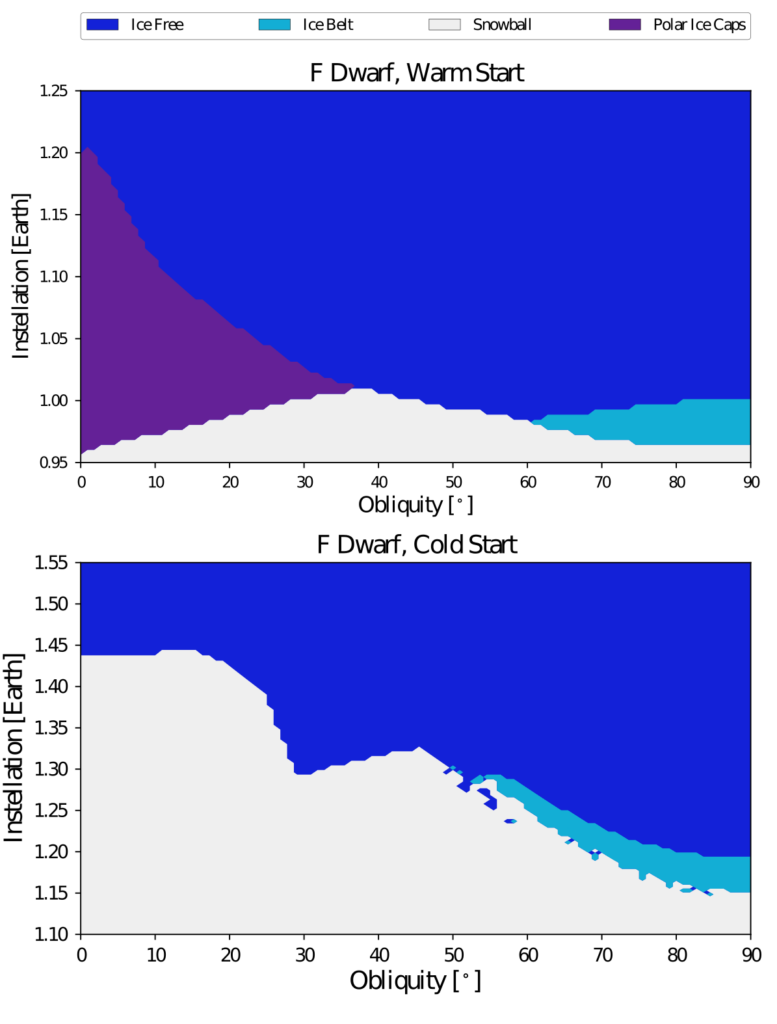
Source: Figure 5 from today’s pap
For cold starts, the authors found that only K dwarf planets are able to retain their polar ice caps, but even those only for a very narrow parameter space, in the vast majority of cases, the low-obliquity scenarios are either entirely ice-free or fully galciated with the transitions between these states occurring at higher instellations than for warm starts. Of course, the cooler the host star, the lower the instellation threshold is for snowball-states, due to the change in albedo.
The authors further examined the influence of increasing eccentricity on the ice sheet formation. They found that for K dwarf planets, ice caps and belts are stable for an eccentricity below 0.4, for G dwarf planets they are stable below an eccentricity of 0.3 and for F star planets, they remain stable for eccentricities below 0.1.
Results for Evolving Planets
Generally, the authors found that ice sheets can be stable on many worlds with variating obliquity and eccentricity values. However, they found that the vast majority of habitable planets orbiting FGK stars are actually ice free. In fact, if one excludes cases which produce a moist greenhouse effect or snowball-states, 90% of planets with surface water are predicted to be free of surface ice. This should not be exceedingly surprising, since Earth itself was entirely ice-free for long periods.

Source: Figure 8 in today’s paper
For the rest of the cases, the results show that for K and G dwarf planets, ice belts are actually twice as likely as polar caps. The reason may be that the initial obliquity distribution strongly favours values around 90°, even though the parameter space for possible ice caps is larger than the one for ice belts and thus making them technically more likely, however not for obliquities around 90°.
For F star planets however, this trend is reversed and icy polar caps were shown to be three times as likely as ice belts, which may be a direct result of the very tiny parameter space for ice belts on these planets.
Figure 4 shows that the variations in albedo, rotational cycle and orbital cycle do not strongly affect the climate states. This means that the type of variations (may it be the rotational period or eccentricity, etc) does not strongly influence the climate outcome. It appears as though the length of season, which is a direct consequence of the host star type, plays a critical role in the stability of surface ice.
The conclusions from this work may be tested with new space telescopes, such as the JWST and beyond, which are capable of measuring the required surface features on habitable exoplanets.
We know for sure that Earth has undergone several different ice coverage states and it is likely that other habitable Earth-like planets have their own dynamic history of climate states related to ice sheets. These simulations provide us with a better idea of what to expect when analysing the surface conditions on exoplanets and exploring their potential for life.
Astrobite edited by Zili Shen
Image Credit: Today’s paper, ESO

